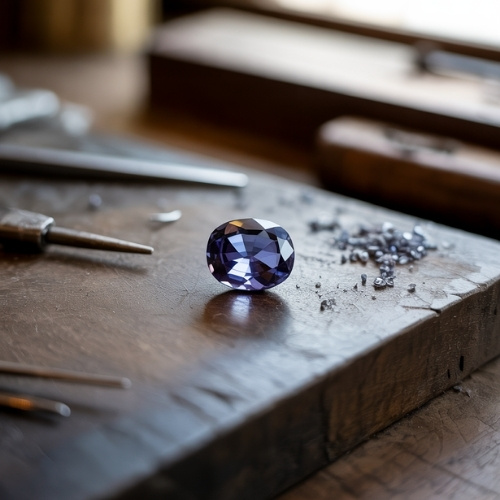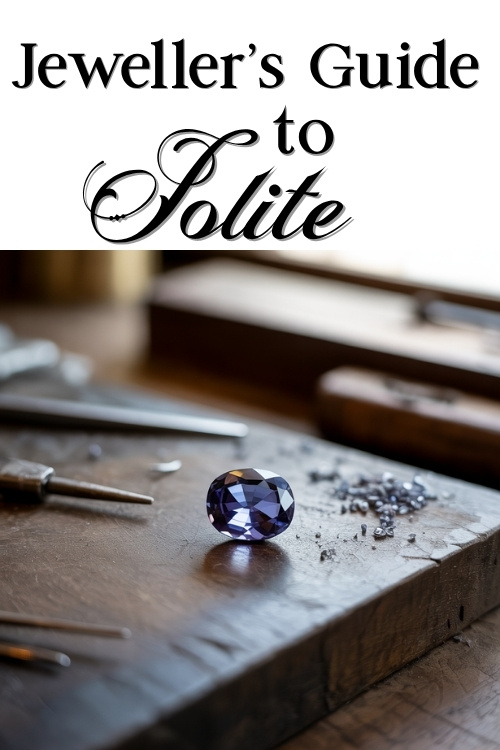Estimated reading time: 4 minutes
With its shifting shades of violet-blue and a history that spans from Viking voyages to modern gem cabinets, iolite is a gemstone full of quiet intrigue. Its pleochroic nature, showing different colours from different angles, gives it an otherworldly depth that captures the imagination. Whether you’re drawn to its affordability, its optical mystery, or its design versatility, iolite has much to offer the jeweller’s bench.
Jump to:
Basic Identification Information
Name & Synonyms
Iolite. Also known as water sapphire, the poor man’s sapphire, or Vikings’ compass
Species
Cordierite
Colour Range
Violet-blue to greyish blue, with strong pleochroism showing yellow, brown, or colourless tones from different viewing angles
Refractive Index
1.522–1.596
Birefringence
0.005–0.018
Optical Sign
Biaxial – or Biaxial +
Usually it’s negative, but not always
Pleochroism
Moderate to Strong and 3 colours
Iron rich crystals: Colorless and violet
Magnesium rich crystals: Pale yellow to green, and pale blue, and violet or violet-blue
Specific Gravity
2.58–2.66
Fluorescence
None
Lustre
Vitreous – Glass-like
Clarity (GIA Clarity Type II)
Type II
Commonly has visible inclusions, although eye clean examples are also available
Gems Often Mistaken For
Tanzanite, sapphire, spinel, kyanite, tourmaline
Mohs Hardness
7–7.5
Wearability
Good overall, but internal cleavage means it can break if struck, especially in exposed settings
Birthstone
Sometimes used as a more affordable alternative to sapphire for September
Spotting Synthetic (Lab-Grown) Iolite
Iolite is not commonly synthesised, and there is currently no widespread market for a lab-grown version. That said, its lookalikes, especially synthetic sapphire or spinel, can occasionally be missold as iolite.
Common Treatments
Most iolite is left untreated, making it one of the more natural choices on the gem market. Very occasionally, low-temperature heat treatment may be used to subtly enhance colour, though this is rare and generally not disclosed.
Durability & Setting Considerations
While iolite’s hardness allows for use in many types of jewellery, its perfect cleavage and internal tension points require careful handling.
Rings and bracelets should offer structural protection with bezel or halo settings to reduce impact risk. Avoid tension settings or cast-in-place designs, as heat shock or pressure can cause fracturing.
When setting, orientation matters: iolite’s pleochroism means the stone can appear dull or washed out if not aligned thoughtfully. Always inspect it from multiple angles before finalising placement.
🛍️ Explore our selection of pre-owned Iolite Gemstones for your next jewellery creation.
Care Instructions
Cleaning
Use lukewarm water, a mild soap, and a soft brush. Avoid ultrasonic or steam cleaners, which may worsen fractures or cause damage from rapid temperature changes.
Storage
Store separately from harder stones like sapphire or diamond to avoid scratches. A soft pouch or lined compartment is ideal.
Daily Wear
Iolite is suitable for everyday wear in protected settings, but take care to avoid knocks or pressure. Remove bracelets and rings before engaging in manual work or sports.
Market & Ethical Notes
Iolite is widely available and generally considered an ethical gem.
Major sources include India, Sri Lanka, Brazil, and Madagascar. Many suppliers work with small-scale mines that follow environmentally and socially responsible practices.
Value is primarily determined by colour saturation and clarity. The most desirable iolites are rich in blue-violet with minimal grey and no eye-visible inclusions.
🔗 Learn more about the ethical and environmental story behind Reclaimed and Recycled Gemstones.
Symbolic & Spiritual Meanings
Long associated with insight and inner vision, iolite is thought to support intuition and mental clarity. Some believe it enhances creativity and helps navigate emotional fog, echoing its nickname as the Vikings’ compass.
In crystal healing, iolite is linked to the third eye and crown chakras, connecting thought, vision, and spiritual awareness.
🔗 Dive deeper into Iolite’s Symbolic & Spiritual Meanings
Etymology
The name “iolite” comes from the Greek word ios, meaning violet, an apt nod to its vibrant hue.
🔗Curious about how iolite was viewed in ancient cultures? Explore its fascinating myths and legends
📌 Save this jeweller’s guide to iolite for quick reference next time you’re working with this stunning gem.


